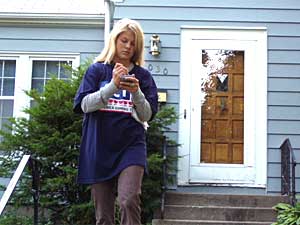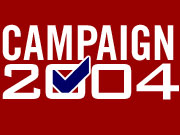Audio
Photos
More from MPR
Resources
Your Voice
| ||||||||||||||||||||||||||||||||||||||||||||||
Campaigns go high tech to get out the vote
August 17, 2004
 |
| Emily Casey with America Coming Together uses her Palm Pilot to store voter data. (MPR Photo/Tom Scheck) |
Minneapolis, Minn. — On a sunny, humid evening, Joel Irish and Emily Casey with the progressive group known as America Coming Together or ACT, are swatting mosquitoes and knocking on doors in a northeast Minneapolis neighborhood.
Door-knockers such as Irish and Casey used to have to carry page after page of information about potential voters gathered at the Secretary of State's office. Now, the two carry Palm Pilots that store such information. With one click, Irish and Casey can shuffle through the eligible voters in the neighborhood. When he finds a voter, Irish doesn't hesitate to ask questions.
"In the election for president, who would you vote for?" Irish asks. The unidentified voter answers, "John Kerry."
 | |||
ACT has 1,300 volunteers going door to door nationwide with these Palm Pilots. Once they get back from a night of canvassing, the information is immediately downloaded into ACT's voter database. ACT's Meighan Stone says the new technology helps them reach out to voters more quickly and with better information.
"It's almost like the election where the 24-hour news cycle first hit. Now this is the first election where technology has become fully in use," Stone says. "It's changed things radically. It's completely impacted how we talk to voters and how we use that information."
Campaigns hope to use the information to send specific e-mail messages and literature to undecided voters. The messages can be timely and targeted to appeal to those voters on issues of interest to them. It's a cheaper, more efficient and much more targeted way to convince voters to support a particular candidate.
The Minnesota Republican Party is taking technology one step further, according to spokesman Joel Cary. Cary says the party wants its most eager activists to tell them about voters who live in their nighborhoods.
Here's how it works. Activists log on to the party's Web site and are given a list of their neighbors. Cary says the activist is then expected to find out the party affiliation of each neighbor on the list, and what issues they care about. Once that information is gathered, it goes directly into the Republican database.
|
This is the first election where technology has become fully in use. It's changed things radically. It's completely impacted how we talk to voters and how we use that information.
- Meighan Stone, America Coming Together |
"What we're asking our activists to do is go identify them," Cary says. "You probably know them. For sure you know the addresses, because it's within a block or two of where you live."
The Republican Party's Randy Wanke says the system, known as Webvoter, is a more efficient way than door-knocking and phone-calling to identify party faithful and undecided voters.
What it means for voters is more personalized pitches. Once a political campaign knows the party affiliation and issues a voter cares about, they can follow up with pro-Bush literature and phone calls. Wanke says it will also save time and money by weeding out confirmed Democrats early on.
"One of the tools in communication is to know your audience," Wanke says. "This is the first step to identify folks and find out where they're at, so we can more effectively talk to them about the things that they're concerned about."
Wanke says Webvoter isn't meant to replace traditional forms of voter identification, but to complement them.
Technology has changed one other aspect of politics -- fundraising. Michael Cornfield, with the Pew Internet and American Life Project in Washington, says one out of every three dollars raised by Democratic candidate John Kerry is through e-mail and the Internet.
"The intensity of this election -- being ratcheted up by the (Iraq) war -- has produced a huge rush of tens of millions of dollars, first to the Dean campaign and now to the Kerry campaign," Cornfield says. "The Bush campaign has a big Internet network as well, but they haven't relied on it as much for fundraising."
It's ironic that much of the money raised through the new technology is being spent on old technology, mainly TV and radio ads. But analysts say the targeted e-mail messages are effective at communicating with small groups of voters. And with an election that's expected to be close, it may be small groups that make the difference.
|
News Headlines
|
Related Subjects
|

